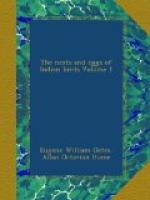Generally the nests are very compact and solid, 6 or 7 inches in diameter, and the egg-cavity 3 to 4 in diameter, and 2 to 21/2 in depth, but I have come across very loosely built and straggling ones.
They have at times two broods in the year (but I do not think that this is always the case), and lay from three to six eggs, four or five being the usual number.
Mr. F.R. Blewitt, writing from Jhansie and Saugor, and detailing his experiences there and in the Delhi Districts, says:—
“The Common Indian Grey Shrike breeds from February to July; it builds on trees; if it has a preference, it is for the close-growing roonj tree (Acacia leucophlaea). I have particularly noticed this fact both here and at Gurhi Hursroo. The nest in structure is neat and compact (though I have occasionally seen some very roughly put together), and generally-well fixed into the forks of an off-shooting branch. In shape it is circular, varying from 5 to 71/2 inches in diameter, and from 11/2 to 31/2 inches in thickness; thorn twigs, coarse grass, grass-roots, old rags, &c. form the outer materials of the nest, and closely interwoven fine grass and roots the border-rim. The egg-cavity is deeply cup-shaped, from 31/2 to 5 inches in diameter, and lined with fine grass and khus; exceptionally shreds of cloth are interwoven with the khus and grass.
“On one occasion I got a nest with the cup interior entirely lined with old cloth pieces, very cleverly and ingeniously worked into the exterior framework. Five is the regular number of eggs, though at times six have been obtained in one nest. The birds often make their own nests each year, but this is not invariably the case. When at Gurhi Hursroo in February last, I found on an isolated roonj tree four nests within a foot of each other. The under centre one, an old Shrike nest (the other three were of other birds), was occupied by a Shrike sitting on five eggs. I very carefully examined it, and my impression at the time was that the parent birds had returned, to rear a second progeny, to the nest constructed by them the year previous.
“I do not know whether you have noticed the fact, but both L. lahtora and L. erythronotus often lay in old nests, of which they first carefully repair the egg-cavity with new materials. It is not only, however, in old nests of their own species that these birds make a home in the breeding-season. At times they take possession of fabrics clearly not the work of any Shrike. Quite recently I found a pair of L. lahtora with four eggs in a small nest entirely woven of hemp, the bottom of which was thickly coated with the droppings of former occupants. Again, on the 8th June, a nest with four eggs was found on a roonj tree. This wonderful nest, which I have kept, is entirely composed of what I take to be old felt and feathers, the bottom of the cavity of which, when found, was almost covered with the dung of young birds.




